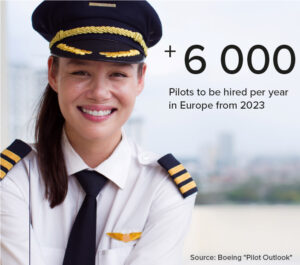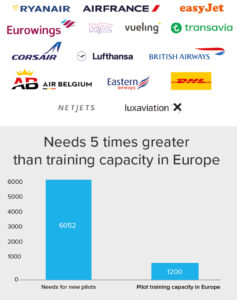All systems are go. We can now officially believe –not just hope– in the return of massive pilot recruitment. Manufacturers, operators and representative bodies all have the same message, with figures to back it up. Astonfly has summarized their outlook for you, as reported by various aviation and economic media.
As we said a few months ago, there is a big difference between previous crises experienced by the aviation sector and the 2020 crisis. The covid crisis was not due to a decrease in demand for travel but to the impossibility of travel. Therefore, as travel conditions have become more flexible, passengers have come back.
In some countries, traffic has exceeded that of 2019. Tourism, business needs and e-commerce-driven cargo are creating a demand for pilots. For many operators–from big names to regional airlines, business and general aviation and low-costs– it is time to recruit.
While a shortage of pilots was predicted for 2020, the sudden interruption in recruitment campaigns and the early retirement plans for senior pilots will add to the growth in industrial and leisure sectors.


Manufacturers confirming upward trend
The recovery which was initially forecast for between 2023 and 2025 is now ongoing for 2022. It has already arrived, with the recovery of regional traffic in China, in the United States and in Europe[1]. To such an extent that Airbus revised its objectives as of the summer of 2021[2]. The strongest signal is undoubtedly the return of “enormous” orders. In the first half of 2021, Airbus had delivered 297 aircraft, 100 more than in the same period in 2020[3]. Though the mid-year review had not yet indicated a return to pre-crisis levels, Airbus has just announced more than 400 orders at the Dubai Airshow[4].
Boeing estimates that 8,700 new aircraft will be needed to satisfy the European market between now and 2040, and that annual growth in passenger traffic will be more than 3%[5].
In a report on the hiring of flight crew and technicians, entitled Pilot and technician outlook 2021-2040[6], the Seattle-based aircraft manufacturer makes a six-figure forecast: 612,000 pilots will have to join the ranks of airlines in the next 20 years, including 115,000 in Europe. In the same report, Boeing stresses the urgent need for ongoing training to maintain a pool of available pilots for operators. It adds, “pilot candidates who begin training today will be very well positioned to take advantage of opportunities when they graduate.”
Another indicator is that the brightening horizon is restarting the old rivalry between Airbus and Boeing[7].
Operators’ doors opening
Last June, Delta Air Lines had already announced a need for 1,000 pilots for the summer of 2022. American Airlines recruited 300 new pilots in 2021, and will welcome twice that number in 2022. Southwest Airlines, without giving figures, is also opening its arms, despite its pool of pilots on furlough. United is looking further ahead, targeting 10,000 recruits by 2030[8]. US regional airlines are even offering hiring bonuses for fear of running out of candidates…[9]
On the old continent, Air France is pursuing its fleet renewal policy, notably with the latest Airbus A220, and is reopening routes. In March 2022, the national airline will have recovered 90% of its 2019 capacity[10].
Wizz Air claims that it will recruit 4,300 new pilots by 2030. It already trained an additional 150 to cover last summer’s capacity, which was 100% up on pre-covid bookings. The Hungarian airline has already opened an online application platform[11]. The same is true in Dublin, where Ryanair is looking to recruit 2,000 pilots over the next three years, and 500 per year thereafter. As for EasyJet, it has just announced that it will be hiring of 1,000 pilots over 5 years. In order to reach the widest possible audience, it is launching an advertising campaign to attract all profiles, from the DJ to the multi-tasking mother[13]. The number given is not an overestimate, since Europe will need 5,000 pilots to keep pace with the number of aircraft orders, while European schools do not have the capacity to train more than 1,000 pilots a year!
This is a different tune – or rather warning – to the one heard in 2020. Pessimism has switched round: the worriers now fear a severe shortage of pilots by the end of the year, with perhaps even some aircraft grounded for lack of pilots.
Up to now, we have only provided an outlook for scheduled airline pilots.
Forecasts are just as optimistic, if not more so, for business aviation, which inspires many student pilots, thanks to the sector’s fleet diversity and versatility of missions. This sector has attracted new customers over the past two years who were either deprived of their usual routes or attracted by the ease and time-saving benefits of private aircraft. Business aviation has already returned to its pre-crisis level.
Thus, the General Aviation Manufacturers’ Association, reports that worldwide deliveries increased in all market segments in the first half of 2021 compared to the same period in 2019: +12.3% for piston engine aircraft, +45.4% for turboprops, +8.2% for jets, +33% for turbine helicopters, +31.7% for piston engine helicopters[14]. The downside however, is that this increase in demand for flights has a heavy impact on the supply of spare parts and the need for pilots[15].
For the future, Honeywell forecasts a need for 7,400 new business jets over the next decade, including 6,500 over the next five years[15].
AOPA, the Aircraft Owners’ association, underlines the enthusiasm of Louis Smith, founder of FAPA (Future and Active Pilot Advisors). With more than 600 pilots hired each month in August and September 2021 by the major “bizav” operators, compared to less than 100 hires last January, “this is the 2nd best score in history!”[17]
On this occasion, AOPA reminds us that the business aviation sector accounts for 37% of commercial pilots.
The entire industry is accelerating
As the aviation industry accelerates its ecological transition, and its operating models become increasingly diversified, the promise of new hires is global, and not just for air transport. For example, Airbus is implementing a recruitment plan for 6,000 employees by 2022[18].
Speaking on behalf of the 400 companies in the industry, GIFAS indicates that 15,000 people will be hired in 2022…
More generally, the French group is pleased with the positive growth in the aerospace sector, at +19.7 billion euros in 2021 vs. +16.3 in 2020. Even though it is far from the record figure for 2019 (+€30.8 billion), aviation remains the leading positive contributor, while foreign trade is increasing its deficit.
Clearly, if you need people to build the aircraft of the future, you’ll need them to fly them! This fabulous world of aviation is quite simply living a new page in its history, adapting, as it has always done, to economic, social and environmental contexts, and innovating. Faster than expected.
Aviation is undoubtedly the industry that has developed the most rapidly. It is breathtaking to think that only 60 years separated Louis Blériot’s feat of crossing the English Channel at less than 60 km/h, from Concorde’s first supersonic flight and the first step on the Moon! Two generations later, a new era is opening in the air. Airliners are burning their first gallons of biofuel, are lighter and more fuel efficient, and are optimizing their trajectories. Electric and hydrogen-powered aircraft, VTOLs and flying cabs are moving from the virtual to the real. They will constitute new modes of operation for air vehicles. We will need young pilots and in the short and medium term, to start a career full of technological discoveries, and the corresponding instructors.
Do you still have questions? Want to chat? Want to know more about our training and our links with recruiters? Don’t hesitate to contact us and take part in our live events and open days.
[6] https://www.boeing.com/commercial/market/pilot-technician-outlook/
[11] https://worldairlinenews.com/2021/08/06/wizz-air-wants-to-hire-4600-new-pilots-by-2030/
[16] https://www.aerobuzz.fr/aviation-affaires/le-marche-des-avions-daffaires-se-redresse/
 whatsapp
whatsapp


